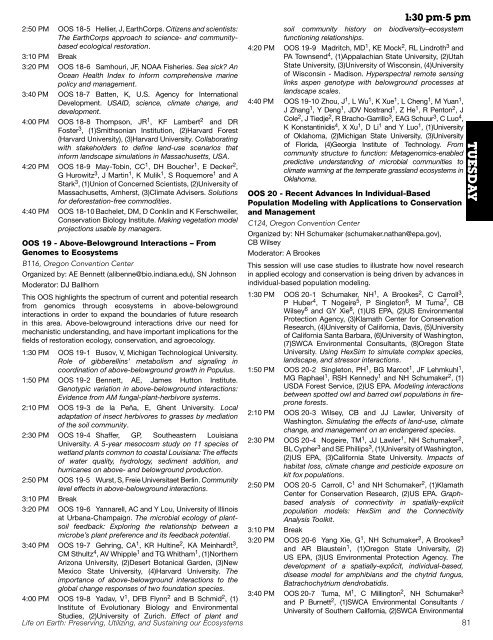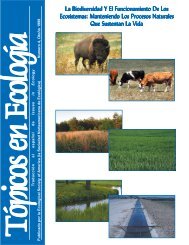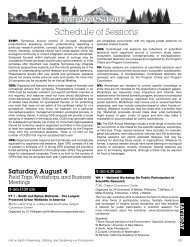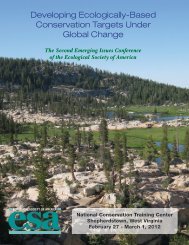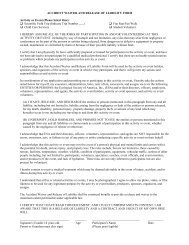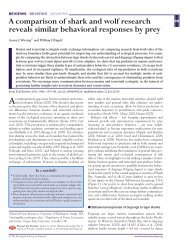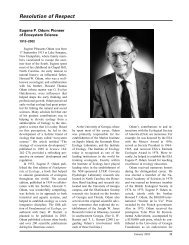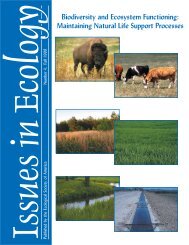Printed Program (PDF) - Ecological Society of America
Printed Program (PDF) - Ecological Society of America
Printed Program (PDF) - Ecological Society of America
Create successful ePaper yourself
Turn your PDF publications into a flip-book with our unique Google optimized e-Paper software.
2:50 PM OOS 18-5 Hellier, J, EarthCorps. Citizens and scientists:<br />
The EarthCorps approach to science- and communitybased<br />
ecological restoration.<br />
3:10 PM Break<br />
3:20 PM OOS 18-6 Samhouri, JF, NOAA Fisheries. Sea sick? An<br />
Ocean Health Index to inform comprehensive marine<br />
policy and management.<br />
3:40 PM OOS 18-7 Batten, K, U.S. Agency for International<br />
Development. USAID, science, climate change, and<br />
development.<br />
4:00 PM OOS 18-8 Thompson, JR 1 , KF Lambert 2 and DR<br />
Foster 3 , (1)Smithsonian Institution, (2)Harvard Forest<br />
(Harvard University), (3)Harvard University. Collaborating<br />
with stakeholders to define land-use scenarios that<br />
inform landscape simulations in Massachusetts, USA.<br />
4:20 PM OOS 18-9 May-Tobin, CC 1 , DH Boucher 1 , E Decker 2 ,<br />
G Hurowitz 3 , J Martin 1 , K Mulik 1 , S Roquemore 1 and A<br />
Stark 3 , (1)Union <strong>of</strong> Concerned Scientists, (2)University <strong>of</strong><br />
Massachusetts, Amherst, (3)Climate Advisers. Solutions<br />
for deforestation-free commodities.<br />
4:40 PM OOS 18-10 Bachelet, DM, D Conklin and K Ferschweiler,<br />
Conservation Biology Institute. Making vegetation model<br />
projections usable by managers.<br />
OOS 19 - Above-Belowground Interactions – From<br />
Genomes to Ecosystems<br />
B116, Oregon Convention Center<br />
Organized by: AE Bennett (alibenne@bio.indiana.edu), SN Johnson<br />
Moderator: DJ Ballhorn<br />
This OOS highlights the spectrum <strong>of</strong> current and potential research<br />
from genomics through ecosystems in above-belowground<br />
interactions in order to expand the boundaries <strong>of</strong> future research<br />
in this area. Above-belowground interactions drive our need for<br />
mechanistic understanding, and have important implications for the<br />
fields <strong>of</strong> restoration ecology, conservation, and agroecology.<br />
1:30 PM OOS 19-1 Busov, V, Michigan Technological University.<br />
Role <strong>of</strong> gibberellins’ metabolism and signaling in<br />
coordination <strong>of</strong> above-belowground growth in Populus.<br />
1:50 PM OOS 19-2 Bennett, AE, James Hutton Institute.<br />
2:10 PM<br />
Genotypic variation in above-belowground interactions:<br />
Evidence from AM fungal-plant-herbivore systems.<br />
OOS 19-3 de la Peña, E, Ghent University. Local<br />
adaptation <strong>of</strong> insect herbivores to grasses by mediation<br />
<strong>of</strong> the soil community.<br />
2:30 PM OOS 19-4 Shaffer, GP, Southeastern Louisiana<br />
2:50 PM<br />
University. A 5-year mesocosm study on 11 species <strong>of</strong><br />
wetland plants common to coastal Louisiana: The effects<br />
<strong>of</strong> water quality, hydrology, sediment addition, and<br />
hurricanes on above- and belowground production.<br />
OOS 19-5 Wurst, S, Freie Universitaet Berlin. Community<br />
level effects in above-belowground interactions.<br />
3:10 PM Break<br />
3:20 PM OOS 19-6 Yannarell, AC and Y Lou, University <strong>of</strong> Illinois<br />
at Urbana-Champaign. The microbial ecology <strong>of</strong> plantsoil<br />
feedback: Exploring the relationship between a<br />
microbe’s plant preference and its feedback potential.<br />
3:40 PM OOS 19-7 Gehring, CA<br />
Life on Earth: Preserving, Utilizing, and Sustaining our Ecosystems<br />
1 , KR Hultine2 , KA Meinhardt3 ,<br />
CM Sthultz4 , AV Whipple1 and TG Whitham1 , (1)Northern<br />
Arizona University, (2)Desert Botanical Garden, (3)New<br />
Mexico State University, (4)Harvard University. The<br />
importance <strong>of</strong> above-belowground interactions to the<br />
global change responses <strong>of</strong> two foundation species.<br />
4:00 PM OOS 19-8 Yadav, V1 , DFB Flynn2 and B Schmid2 , (1)<br />
Institute <strong>of</strong> Evolutionary Biology and Environmental<br />
Studies, (2)University <strong>of</strong> Zurich. Effect <strong>of</strong> plant and<br />
1:30 pm-5 pm<br />
soil community history on biodiversity–ecosystem<br />
4:20 PM<br />
functioning relationships.<br />
OOS 19-9 Madritch, MD1 , KE Mock2 , RL Lindroth3 and<br />
PA Townsend4 , (1)Appalachian State University, (2)Utah<br />
State University, (3)University <strong>of</strong> Wisconsin, (4)University<br />
<strong>of</strong> Wisconsin - Madison. Hyperspectral remote sensing<br />
links aspen genotype with belowground processes at<br />
landscape scales.<br />
4:40 PM OOS 19-10 Zhou, J1 , L Wu1 , K Xue1 , L Cheng1 , M Yuan1 ,<br />
J Zhang1 , Y Deng1 , JDV Nostrand1 , Z He1 , R Penton2 , J<br />
Cole2 , J Tiedje2 , R Bracho-Garrillo3 , EAG Schuur3 , C Luo4 ,<br />
K Konstantinidis4 , X Xu1 , D Li1 and Y Luo1 , (1)University<br />
<strong>of</strong> Oklahoma, (2)Michigan State University, (3)University<br />
<strong>of</strong> Florida, (4)Georgia Institute <strong>of</strong> Technology. From<br />
community structure to function: Metagenomics-enabled<br />
predictive understanding <strong>of</strong> microbial communities to<br />
climate warming at the temperate grassland ecosystems in<br />
Oklahoma.<br />
OOS 20 - Recent Advances In Individual-Based<br />
Population Modeling with Applications to Conservation<br />
and Management<br />
C124, Oregon Convention Center<br />
Organized by: NH Schumaker (schumaker.nathan@epa.gov),<br />
CB Wilsey<br />
Moderator: A Brookes<br />
This session will use case studies to illustrate how novel research<br />
in applied ecology and conservation is being driven by advances in<br />
individual-based population modeling.<br />
1:30 PM OOS 20-1 Schumaker, NH1 , A Brookes2 , C Carroll3 ,<br />
P Huber4 , T Nogeire5 , P Singleton6 , M Tuma7 , CB<br />
Wilsey6 and GY Xie8 , (1)US EPA, (2)US Environmental<br />
Protection Agency, (3)Klamath Center for Conservation<br />
Research, (4)University <strong>of</strong> California, Davis, (5)University<br />
<strong>of</strong> California Santa Barbara, (6)University <strong>of</strong> Washington,<br />
(7)SWCA Environmental Consultants, (8)Oregon State<br />
University. Using HexSim to simulate complex species,<br />
landscape, and stressor interactions.<br />
1:50 PM OOS 20-2 Singleton, PH1 , BG Marcot1 , JF Lehmkuhl1 ,<br />
MG Raphael1 , RSH Kennedy1 and NH Schumaker2 , (1)<br />
USDA Forest Service, (2)US EPA. Modeling interactions<br />
between spotted owl and barred owl populations in fireprone<br />
forests.<br />
2:10 PM OOS 20-3 Wilsey, CB and JJ Lawler, University <strong>of</strong><br />
Washington. Simulating the effects <strong>of</strong> land-use, climate<br />
change, and management on an endangered species.<br />
2:30 PM OOS 20-4 Nogeire, TM1 , JJ Lawler1 , NH Schumaker2 ,<br />
BL Cypher3 and SE Phillips3 , (1)University <strong>of</strong> Washington,<br />
(2)US EPA, (3)California State University. Impacts <strong>of</strong><br />
habitat loss, climate change and pesticide exposure on<br />
kit fox populations.<br />
2:50 PM OOS 20-5 Carroll, C1 and NH Schumaker2 , (1)Klamath<br />
Center for Conservation Research, (2)US EPA. Graphbased<br />
analysis <strong>of</strong> connectivity in spatially-explicit<br />
population models: HexSim and the Connectivity<br />
Analysis Toolkit.<br />
3:10 PM Break<br />
3:20 PM OOS 20-6 Yang Xie, G1 , NH Schumaker2 , A Brookes3 and AR Blaustein1 , (1)Oregon State University, (2)<br />
US EPA, (3)US Environmental Protection Agency. The<br />
development <strong>of</strong> a spatially-explicit, individual-based,<br />
disease model for amphibians and the chytrid fungus,<br />
Batrachochytrium dendrobatidis.<br />
3:40 PM OOS 20-7 Tuma, M1 , C Millington2 , NH Schumaker3 and P Burnett2 , (1)SWCA Environmental Consultants /<br />
University <strong>of</strong> Southern California, (2)SWCA Environmental<br />
TUESDAY<br />
81


